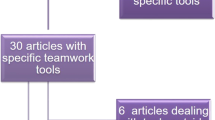Abstract
Background
Operative management of severe trauma requires excellent communication among team members. The surgeon and anesthesiologist need to interact efficiently, exchanging vital information. The Definitive Surgical Trauma Care (DSTC) and Definitive Anesthesia Trauma Care (DATC) courses provide an excellent opportunity for teamwork training. Our goal was to study the impact of the joint DSTC–DATC courses in candidates’ self-reported assessment in communication skills and techniques in a simulated intraoperative trauma scenario.
Methods
Study population consists of 93 candidates (67 surgeons and 26 anesthesiologists) participating in four consecutive joint DSTC–DATC courses in May and June 2019 in Brazil (3) and in Portugal (1). Median age was 30 years; 53 (60%) of subjects were male (46 senior residents and 47 specialists). All participants attended joint lectures, case discussions and surgical skills session, emphasizing intraoperative communication. Post-course survey on several aspects of perioperative communication (responses on a Likert scale) was conducted with participants being asked which aspects of intraoperative communication they valued the most.
Results
All participants responded to the survey. Results displayed an increase in the self-assessed importance of team briefing and intraoperative communication, particularly routine periodic communication, rather than only at critical moments. Postoperative team debriefing was also valued as highly relevant. Closed-loop and direct, by-name communication were highly rated. Self-reported communication skills improved significantly during the course.
Conclusions
Joint training in the DSTC–DATC courses improved candidates’ perception and skills on proficient intraoperative communication. Further studies should address both the durability of these changes and the potential impact on patient care.





Similar content being viewed by others
References
Alexandrino H, Baptista S, Mesquita C (2018) Surgical education in trauma: physiology, damage control and the DSTC™ course. Clin Educ Med Simul 1:5–10
Hirschberg A, Mattox KL (2005) Top knife: the art and craft of trauma surgery. In: Top knife, pp 100–106
Sonesson L, Boffard K, Lundberg L, Rydmark M, Karlgren K (2018) Decision-making in management of the complex Trauma patient: changing the mindset of the non-Trauma surgeon. World J Surg 42(8):2392–2397. https://doi.org/10.1007/s00268-018-4460-x
Cooper JB (2018) Critical role of the surgeon-anesthesiologist relationship for patient safety. J Am Coll Surg 227(3):382–386
Rotondo MF, Schwab CW, McGonigal MD, Phillips GR, Fruchterman TM, Kauder DR et al (1993) “Damage control”: an approach for improved survival in exsanguinating penetrating abdominal injury. J Trauma 35(3):375–382
Doll D, Eichler M, Vassiliu P, Boffard K, Pohlemann T, Degiannis E (2017) Penetrating thoracic Trauma patients with gross physiological derangement: a responsibility for the general surgeon in the absence of Trauma or cardiothoracic surgeon? World J Surg 41(1):170–175. https://doi.org/10.1007/s00268-016-3703-y
McLaughlin C, Barry W, Barin E, Kysh L, Auerbach MA, Upperman JS et al (2019) Multidisciplinary simulation-based team training for Trauma resuscitation: a scoping review. J Surg Educ 76:1669–1680
Long AM, Lefebvre CM, Masneri DA, Mowery NT, Chang MC, Johnson JE et al (2019) The golden opportunity: multidisciplinary simulation training improves Trauma team efficiency. J Surg Educ 76(4):1116–1121
Boffard KD (2019) Manual of definitive surgical trauma care: incorporating definitive anaesthetic trauma care. CRC Press
Sonesson L, Boffard K, Lundberg L, Rydmark M, Karlgren K (2018) The potential of blended learning in education and training for advanced civilian and military trauma care. Injury 49(1):93–96
Arul GS, Pugh HEJ, Mercer SJ, Midwinter MJ (2015) Human factors in decision making in major trauma in Camp Bastion, Afghanistan. Ann R Coll Surg Engl 97(4):262–268
Brindley PG, Reynolds SF (2011) Improving verbal communication in critical care medicine. J Crit Care 26(2):155–159
Gillman LM, Brindley PG, Blaivas M, Widder S, Karakitsos D (2016) Trauma team dynamics. J Crit Care 32:218–221
Boffard K (ed) (2016) Manual of definitive surgical trauma care, 4th edn. Taylor & Francis, Routledge
Suliburk JW, Buck QM, Pirko CJ, Massarweh NN, Barshes NR, Singh H et al (2019) Analysis of human performance deficiencies associated with surgical adverse events. JAMA Netw Open 2(7):e198067
Göras C, Olin K, Unbeck M, Pukk-Härenstam K, Ehrenberg A, Tessma MK et al (2019) Tasks, multitasking and interruptions among the surgical team in an operating room: a prospective observational study. BMJ Open 9(5):e026410
Columbus AB, Castillo-Angeles M, Berry WR, Haider AH, Salim A, Havens JM (2018) An evidence-based intraoperative communication tool for emergency general surgery: a pilot study. J Surg Res 228:281–289
Gjeraa K, Møller TP, Østergaard D (2014) Efficacy of simulation-based trauma team training of non-technical skills. A systematic review. Acta Anaesthesiol Scand 58:775–787
Kolbe M, Boos M (2019) Laborious but elaborate: the benefits of really studying team dynamics. Front Psychol 10:1478
Hansen KS, Uggen PE, Brattebø G, Wisborg T (2007) Training operating room teams in damage control surgery for Trauma: a followup study of the norwegian model. J Am Coll Surg 205(5):712–716
Pereira BMT, Pereira AMT, Correia CDS, Marttos AC, Fiorelli RKA, Fraga GP (2019) Interruptions and distractions in the trauma operating room: understanding the threat of human error. Rev Col Bras Cir 38(5):292–298
Eppich WJ, Mullan PC, Brett-Fleegler M, Cheng A (2016) “Let’s talk about it”: translating lessons from health care simulation to clinical event debriefings and coaching conversations. Clin Pediatr Emerg Med 17(3):200–211
Sparks JL, Crouch DL, Sobba K, Evans D, Zhang J, Johnson JE et al (2017) Association of a surgical task during training with team skill acquisition among surgical residents: the missing piece in multidisciplinary team training. JAMA Surg 152(9):818–825
Author information
Authors and Affiliations
Corresponding author
Ethics declarations
Conflict of interest
All authors report no conflict of interests.
Ethical standards
All ethical standards were applied.
Informed consent
Informed consent was obtained from the study subjects.
Additional information
Publisher's Note
Springer Nature remains neutral with regard to jurisdictional claims in published maps and institutional affiliations.
Electronic supplementary material
Below is the link to the electronic supplementary material.
Rights and permissions
About this article
Cite this article
Alexandrino, H., Baptista, S., Vale, L. et al. Improving Intraoperative Communication in Trauma: The Educational Effect of the Joint DSTC™–DATC™ Courses. World J Surg 44, 1856–1862 (2020). https://doi.org/10.1007/s00268-020-05421-5
Published:
Issue Date:
DOI: https://doi.org/10.1007/s00268-020-05421-5




